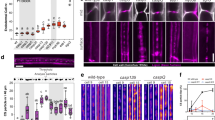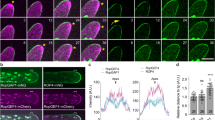Abstract
Casparian strips are precisely localized and aligned ring-like cell wall modifications in the root of all higher plants. They set up an extracellular diffusion barrier analogous to animal tight junctions, and are crucial for maintaining the homeostatic capacity of plant roots. Casparian strips become localized because of the formation of a highly stable plasma membrane domain, consisting of a family of small transmembrane proteins called Casparian strip membrane domain proteins (CASPs). Here we report a large-scale forward genetic screen directly visualizing endodermal barrier function, which allowed us to identify factors required for the formation and integrity of Casparian strips. We present the identification and characterization of one of the mutants, schengen1 (sgn1), a receptor-like cytoplasmic kinase that we show localizes in a strictly polar fashion to the outer plasma membrane of endodermal cells and is required for the positioning and correct formation of the centrally located CASP domain.
This is a preview of subscription content, access via your institution
Access options
Subscribe to this journal
Receive 12 digital issues and online access to articles
$119.00 per year
only $9.92 per issue
Buy this article
- Purchase on Springer Link
- Instant access to full article PDF
Prices may be subject to local taxes which are calculated during checkout





Similar content being viewed by others
References
Alassimone, J., Roppolo, D., Geldner, N. & Vermeer, J. E. M. The endodermis—development and differentiation of the plant's inner skin. Protoplasma 249, 433–443 (2011).
Geldner, N. The endodermis. Annu. Rev. Plant Biol. 64, 531–558 (2013).
Alassimone, J., Naseer, S. & Geldner, N. A developmental framework for endodermal differentiation and polarity. Proc. Natl Acad. Sci. USA 107, 5214–5219 (2010).
Takano, J. et al. Polar localization and degradation of Arabidopsis boron transporters through distinct trafficking pathways. Proc. Natl Acad. Sci. USA 107, 5220–5225 (2010).
Roppolo, D. et al. Functional and evolutionary analysis of the CASPARIAN STRIP MEMBRANE DOMAIN PROTEIN family. Plant Physiol. 165, 1709–1722 (2014).
Roppolo, D. et al. A novel protein family mediates Casparian strip formation in the endodermis. Nature 473, 380–383 (2011).
Pfister, A. et al. A receptor-like kinase mutant with absent endodermal diffusion barrier displays selective nutrient homeostasis defects. eLife 3, e03115 (2014).
Tsuwamoto, R., Fukuoka, H. & Takahata, Y. GASSHO1 and GASSHO2 encoding a putative leucine-rich repeat transmembrane-type receptor kinase are essential for the normal development of the epidermal surface in Arabidopsis embryos. Plant J. 54, 30–42 (2008).
Lee, Y., Rubio, M. C., Alassimone, J. & Geldner, N. A mechanism for localized lignin deposition in the endodermis. Cell 153, 402–412 (2013).
Torres, M. A., Dangl, J. L. & Jones, J. D. G. Arabidopsis gp91phox homologues AtrbohD and AtrbohF are required for accumulation of reactive oxygen intermediates in the plant defense response. Proc. Natl Acad. Sci. USA 99, 517–522 (2002).
Kwak, J. M. NADPH oxidase AtrbohD and AtrbohF genes function in ROS-dependent ABA signaling in Arabidopsis. EMBO J. 22, 2623–2633 (2003).
Jammes, F. et al. MAP kinases MPK9 and MPK12 are preferentially expressed in guard cells and positively regulate ROS-mediated ABA signaling. Proc. Natl Acad. Sci. USA 106, 20520–20525 (2009).
Jiang, C. et al. ROS-mediated vascular homeostatic control of root-to-shoot soil Na delivery in Arabidopsis. EMBO J. 31, 4359–4370 (2012).
Veronese, P. et al. The membrane-anchored BOTRYTIS-INDUCED KINASE1 plays distinct roles in Arabidopsis resistance to necrotrophic and biotrophic pathogens. Plant Cell 18, 257–273 (2006).
Lu, D. et al. A receptor-like cytoplasmic kinase, BIK1, associates with a flagellin receptor complex to initiate plant innate immunity. Proc. Natl Acad. Sci. USA 107, 496–501 (2010).
Li, L. et al. The FLS2-associated kinase BIK1 directly phosphorylates the NADPH oxidase RbohD to control plant immunity. Cell Host Microbe 15, 329–338 (2014).
Kadota, Y. et al. Direct regulation of the NADPH oxidase RBOHD by the PRR-associated kinase BIK1 during plant immunity. Mol. Cell 54, 43–55 (2014).
Broothaerts, W. et al. Gene transfer to plants by diverse species of bacteria. Nature 433, 629–633 (2005).
Helariutta, Y. et al. The SHORT-ROOT gene controls radial patterning of the Arabidopsis root through radial signaling. Cell 101, 555–567 (2000).
Shiu, S.-H. & Bleecker, A. B. Expansion of the receptor-like kinase/pelle gene family and receptor-like proteins in Arabidopsis. Plant Physiol. 132, 530–543 (2003).
Lehti-Shiu, M. D., Zou, C., Hanada, K. & Shiu, S.-H. Evolutionary history and stress regulation of plant receptor-like kinase/pelle genes. Plant Physiol. 150, 12–26 (2009).
Kim, T.-W., Guan, S., Burlingame, A. L. & Wang, Z.-Y. The CDG1 kinase mediates brassinosteroid signal transduction from BRI1 receptor kinase to BSU1 phosphatase and GSK3-like kinase BIN2. Mol. Cell 43, 561–571 (2011).
Swiderski, M. R. & Innes, R. W. The Arabidopsis PBS1 resistance gene encodes a member of a novel protein kinase subfamily. Plant J. 26, 101–112 (2001).
Zhang, J. et al. Receptor-like cytoplasmic kinases integrate signaling from multiple plant immune receptors and are targeted by a Pseudomonas syringae effector. Cell Host Microbe 7, 290–301 (2010).
Laluk, K. et al. Biochemical and genetic requirements for function of the immune response regulator BOTRYTIS-INDUCED KINASE1 in plant growth, ethylene signaling, and PAMP-triggered immunity in Arabidopsis. Plant Cell 23, 2831–2849 (2011).
Zhang, X. et al. Overexpression of Arabidopsis MAP kinase kinase 7 leads to activation of plant basal and systemic acquired resistance. Plant J. 52, 1066–1079 (2007).
Kodama, Y., Tamura, T., Hirasawa, W., Nakamura, K. & Sano, H. A novel protein phosphorylation pathway involved in osmotic-stress response in tobacco plants. Biochimie 91, 533–539 (2009).
Hwang, I. & Goodman, H. M. An Arabidopsis thaliana root-specific kinase homolog is induced by dehydration, ABA, and NaCl. Plant J. 8, 37–43 (1995).
Liu, J. et al. Membrane-bound RLCKs LIP1 and LIP2 are essential male factors controlling male-female attraction in Arabidopsis. Curr. Biol. 23, 993–998 (2013).
Hemsley, P. A., Weimar, T., Lilley, K. S., Dupree, P. & Grierson, C. S. A proteomic approach identifies many novel palmitoylated proteins in Arabidopsis. New Phytol. 197, 805–814 (2013).
Qi, D. et al. Recognition of the protein kinase AVRPPHB SUSCEPTIBLE1 by the disease resistance protein RESISTANCE TO PSEUDOMONAS SYRINGAE5 is dependent on S-Acylation and an exposed loop in AVRPPHB SUSCEPTIBLE1. Plant Physiol. 164, 340–351 (2014).
Banks, J. A. et al. The Selaginella genome identifies genetic changes associated with the evolution of vascular plants. Science 332, 960–963 (2011).
Rensing, S. A. et al. The Physcomitrella genome reveals evolutionary insights into the conquest of land by plants. Science 319, 64–69 (2008).
Hanks, S. K. & Hunter, T. Protein kinases 6. The eukaryotic protein kinase superfamily: kinase (catalytic) domain structure and classification. FASEB J. 9, 576–596 (1995).
Naseer, S. et al. Casparian strip diffusion barrier in Arabidopsis is made of a lignin polymer without suberin. Proc. Natl Acad. Sci. USA 109, 10101–10106 (2012).
Hosmani, P. S. et al. Dirigent domain-containing protein is part of the machinery required for formation of the lignin-based Casparian strip in the root. Proc. Natl Acad. Sci. USA 110, 14498–14503 (2013).
Kamiya, T. et al. The MYB36 transcription factor orchestrates Casparian strip formation. Proc. Natl Acad. Sci. USA 112, 10533–10538 (2015).
Langowski, L., Růzicka, K., Naramoto, S., Kleine-Vehn, J. & Friml, J. Trafficking to the outer polar domain defines the root-soil interface. Curr. Biol. 20, 904–908 (2010).
Ueda, T. Ara6, a plant-unique novel type Rab GTPase, functions in the endocytic pathway of Arabidopsis thaliana. EMBO J. 20, 4730–4741 (2001).
Abrami, L., Kunz, B., Iacovache, I. & van der Goot, F. G. Palmitoylation and ubiquitination regulate exit of the Wnt signaling protein LRP6 from the endoplasmic reticulum. Proc. Natl Acad. Sci. USA 105, 5384–5389 (2008).
Kümmel, D., Heinemann, U. & Veit, M. Unique self-palmitoylation activity of the transport protein particle component Bet3: a mechanism required for protein stability. Proc. Natl Acad. Sci. USA 103, 12701–12706 (2006).
Rocks, O. et al. An acylation cycle regulates localization and activity of palmitoylated ras isoforms. Science 307, 1746–1752 (2005).
Hachet, O. et al. A phosphorylation cycle shapes gradients of the DYRK family kinase pom1 at the plasma membrane. Cell 145, 1116–1128 (2011).
Kleinboelting, N., Huep, G., Kloetgen, A., Viehoever, P. & Weisshaar, B. GABI-Kat SimpleSearch: new features of the Arabidopsis thaliana T-DNA mutant database. Nucleic Acids Res. 40, D1211–D1215 (2012).
Vermeer, J. E. M. et al. A spatial accommodation by neighboring cells is required for organ initiation in Arabidopsis. Science 343, 178–183 (2014).
Seki, M. et al. Functional annotation of a full-length Arabidopsis cDNA collection. Science 296, 141–145 (2002).
Seki, M., Carninci, P., Nishiyama, Y., Hayashizaki, Y. & Shinozaki, K. High-efficiency cloning of Arabidopsis full-length cDNA by biotinylated CAP trapper. Plant J. 15, 707–720 (1998).
Clough, S. J. & Bent, A. F. Floral dip: a simplified method for Agrobacterium-mediated transformation of Arabidopsis thaliana. Plant J. 16, 735–743 (1998).
Fujita, S. et al. An atypical tubulin kinase mediates stress-induced microtubule depolymerization in Arabidopsis. Curr. Biol. 23, 1969–1978 (2013).
R Core Team. R: A Language and Environment for Statistical Computing (R Foundation for Statistical Computing, 2014).
Acknowledgements
We thank the Central Imaging Facility (CIF) and the Genome Technology Facility (GTF) of the University of Lausanne for expert technical support, as well as V. Dénervaud Tendon and S. Ammar for technical assistance. We wish to thank D. Roppolo, E. N. M. Dohmann, Y. Lee and D. Salt for helpful discussions; D. Salt for sharing material before publication; and T. Kohchi and R. Nishihama from Kyoto University for unpublished sequences. This work was funded by grants from the Swiss National Science Foundation (SNSF) and the European Research Council (ERC) grants Plant-Memb-Traff and ENDOFUN to N.G. J.E.M.V. was supported by a Marie-Curie intra-European fellowship, M.B. by a EMBO long-term postdoctoral fellowship, S.F. by a JSPS postdoctoral fellowship for research abroad and V.G.D. by the Fundación Alfonso Martín Escudero.
Author information
Authors and Affiliations
Contributions
N.G. and J.A. initiated the project. J.A., S.F., V.G.D., J.E.M.V. and N.G. designed experiments. J.A., S.F., V.G.D, M.v.D., M.B., L.K., J.E.M.V., N.R.M, L.S., C.H. and N.G. performed experiments and interpreted the results. L.K. provided unpublished plant materials. Manuscript written by J.A., S.F. and N.G. All authors edited and commented on the manuscript.
Corresponding author
Ethics declarations
Competing interests
The authors declare no competing financial interests.
Supplementary information
Supplementary Information
Supplementary Figs 1–4, Supplementary Table 1 and Supplementary Materials and Methods. (PDF 1390 kb)
Rights and permissions
About this article
Cite this article
Alassimone, J., Fujita, S., Doblas, V. et al. Polarly localized kinase SGN1 is required for Casparian strip integrity and positioning. Nature Plants 2, 16113 (2016). https://doi.org/10.1038/nplants.2016.113
Received:
Accepted:
Published:
DOI: https://doi.org/10.1038/nplants.2016.113
This article is cited by
-
Directed growth and fusion of membrane-wall microdomains requires CASP-mediated inhibition and displacement of secretory foci
Nature Communications (2023)
-
A new family of proteins is required for tethering of Casparian strip membrane domain and nutrient homoeostasis in rice
Nature Plants (2023)
-
SbCASP-LP1C1 improves salt exclusion by enhancing the root apoplastic barrier
Plant Molecular Biology (2023)
-
Extracellular vesiculo-tubular structures associated with suberin deposition in plant cell walls
Nature Communications (2022)
-
A dirigent family protein confers variation of Casparian strip thickness and salt tolerance in maize
Nature Communications (2022)



